Zuo-Guang. Ye Advanced Dielectric Piezoelectric and Ferroelectric Materials: Synthesis, Characterisation and Applications
Подождите немного. Документ загружается.

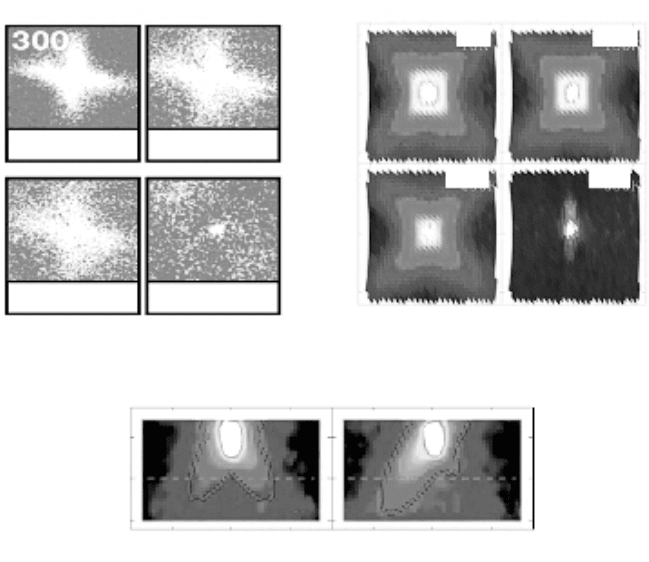
Handbook of dielectric, piezoelectric and ferroelectric materials410
Vakhrushev et al., (2007) demonstrated that the observed anisotropic diffuse
scattering can be very well reconstructed by strain field produced by defects
of tetragonal symmetry (Fig. 14.12).
In contrast, the application of an electric field does not lead to the suppression
of the diffuse scattering
and even under a high-strength field (40kV/cm), the
‘butterfly-shape’ diffuse scattering is only partially affected (Xu et al., 2006):
a redistribution of the intensity occurs via changes in elastic constants. With
the assumption that the butterfly-shape diffuse scattering originates only in
polar nanoregions, one might expect the diffuse scattering to disappear because
the electric field is, in principle, strong enough to align these nanoregions
and to achieve a uniform polar state. The fact that this is not observed
suggests that the polar defects that are supposed to be responsible for the
anisotropic diffuse scattering are coupled to a deformation that inhibits the
alignment of the PNRs. It is this idea that has been developed in this section.
We would like to come back to the question of local symmetry of PNRs
(whether it is rhombohedral, tetragonal or monoclinic) and their mere existence
Pressure Temperature
0.1 GPA 1.5 GPA
3.6 GPA > 4.5 GPA
K
(reciprocal lattice unit)
0.1
0.0
0.1
0.1
0.0
–0.1
PMN (100)
10 K
500 K
250 K
650 K
0.9 1.0 1.10.9 1.0 1.1
H
(reciprocal lattice unit)
Electric field
E
= 0
E
II
[111]
(a) (b)
–0.1 0 0.1 –0.1 0 0.1
(0,
K
,
K
)
(H, O, O)
3.00
2.50
2.00
14.11
Diffuse scattering around <
h
00>; evolution with pressure in
PMN (Chaabane
et al.
, 2003a), temperature in PMN (Xu
et al.
, 2004)
and electric field in PZN (Xu
et al.
, 2005).
WPNL2204
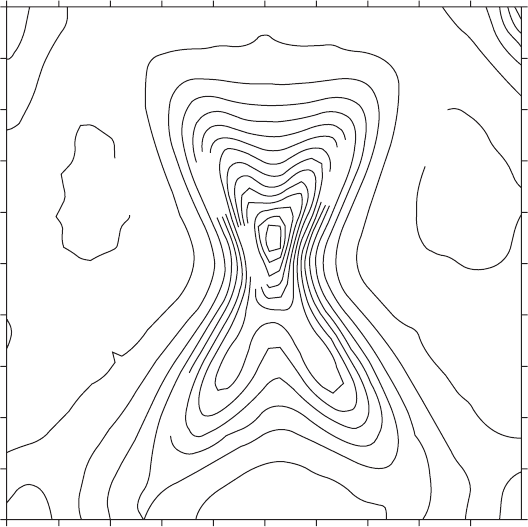
From the structure of relaxors to the structure of MPB 411
as a well-delimited zone of polar correlation with an abrupt boundary. This
section shows that the reality is obviously much more complex. Indeed, a
glance at Fig. 14.13 readily shows that these questions, as well as the question
of a clear separation between PNRs and CORs, are due to the need to build
simplistic objects which should help us to understand reality: there is no
clear separation between PNRs, CORs and the monoclinic adaptative zone
(see Section 14.4.2).
To conclude this section a few words have to be added to the connection
of the structural pictures of relaxors presented here and the theoretical
background. Some years ago, in parallel to phenomenological models, random
field models with ideas issued from renormalisation theories were developed
in particular to explain the experimental observations of non-mean-field
critical exponent. The success of these types of model was important, but still
conflicting results with experiments pointed out the important part played by
the point or extended defects: there was clearly a need to take into account
these defects in the models. The notion of ‘random field’ is one way, among
several, to explain more accurately the experimental observations by taking
into account some types of defects. In the field of relaxors, the Imry and Ma
4000.00
4000.00
14000.00
14000.00
14000.00
24000.00
–2.50
–2.60
–2.70
–2.80
–2.90
–3.00
–3.10
–3.20
–3.30
–3.40
–3.50
–0.50 –0.40 –0.30 –0.20 –0.10 0.00 0.10 0.20 0.30 0.40
14.12
Calculated 2D plot of the diffuse scattering intensity
distribution in PMN near the (003) point.
WPNL2204
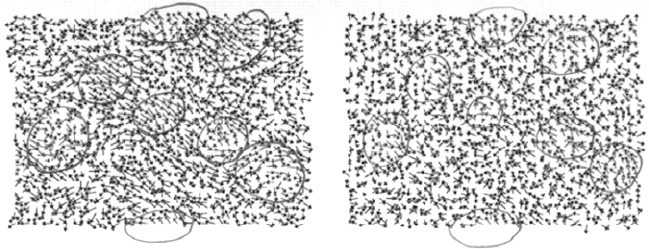
Handbook of dielectric, piezoelectric and ferroelectric materials412
argument was used by Kleemann (1993) to explain the diffuseness of PMN
by quenched random electric field arising from charged compositional
fluctuations and inducing a nanodomain state. However, other approaches,
based on random bond interaction and giving rise to glassy behaviour, were
also developed: that is why relaxors are sometime also called glassy ferroelectrics.
The situation has been clarified by Pirc and Blinc (1999) who developed
the random bond–random field model. In this model, the PNRs not only
interact between each other as expected in classical glass-like systems
(dipolar or quadrupolar) but may also interact with random fields arising from
the compositionally chemical disorder. In this model the change with temperature
from isotropic (Heisenberg) to discrete value of the order parameter is considered.
And this is indeed what is observed from the experimental point of view (see
Fig. 14.5 for instance, showing the isotropic to anisotropic positions of lead
atoms). However, this model considers pseudospins (as PNRs) interactions
with quenched random electric fields and describes in an elegant manner
the static behaviour of relaxors but it cannot currently satisfactorily describe
the dynamic properties and, especially, the dielectric relaxation.
14.4 Towards the MPB: substitution of titanium
14.4.1 Rotation of polarisation via monoclinic phase
In this section we summarise the current situation in some MPB systems
from the standpoint of the long-range polar order. Indeed as is shown in
Section 14.4.2 the question of symmetry in these systems is a difficult one as
there is a progressive transformation of local to long-range polar order: for
instance PMN can be viewed as, ‘on average’, a cubic phase but we have
seen that at low temperature frozen PNRs exist. Moreover, a very small
(a) (b)
14.13
Snapshot of local mode polarisation in (a) PSN at 600K and
(b) PMN at 130K. More highly correlated circled regions are
chemically ordered and the more disordered matrix is chemically
disordered. From calculations by Burton
et al.
(2006).
WPNL2204
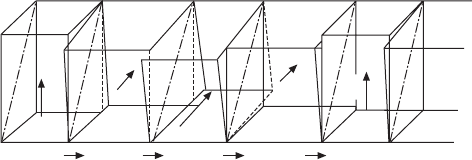
From the structure of relaxors to the structure of MPB 413
amount of titaniums doping transforms the local polar order into, ‘on average’
a rhombohedral phase in which local monoclinic regions might still manifest
themselves. These difficulties are in fact more or less identical to the question
of the exact symmetry of the PNRs in non-doped compounds as discussed
above: can they be considered as a rhombohedral polar order with a monoclinic
zone of adaptation between the tetragonal symmetry imposed by the CORs?
Again Fig. 14.13 shows the difficulty of clearly separating or even identifying
the different objects under consideration.
Before the discovery of the monoclinic phase in the MPB of PZT (Noheda
et al., 1999) the rotation of polarisation between the rhombohedral and the
tetragonal phase was explained by a complex texture of microdomains (Lucuta,
1989) as shown in Fig. 14.14. The joint experimental and theoretical works
showed that the key point for explaining the giant piezoelectric properties
inside the MPB, i.e. the huge effect of a weak electric field on the direction
and magnitude of polarisation, is the fact that in a monoclinic phase the
polarisation is no longer restricted along a linear direction ([111] or [100] for
instance) but can rotate freely in a plane. In fact, up to now several monoclinic
phases have been discussed and evidenced. These phases are easily visualised
and related to the other ferroelectric phase via a picture proposed by Fu and
Cohen (2000) (Fig. 14.15).
PZT phase diagram
The situation in PZT (Fig. 14.16) has been discussed by several authors, in
particular by Noheda (2002). A unique monoclinic phase of the M
A
type was
evidenced in addition to the adjacent tetragonal and rhombohedral phases.
However a distinction must be made regarding the low-temperature
rhombohedral phase in which a rotation of oxygen octahedra occurs along
the [111] direction in addition to the ferroelectric shifts of the R3m phase,
inducing an R3c phase. Persistence of superlattice reflections inside the
concentration range of the monoclinic phase raises the question of the exact
space group for these concentration: if long ranged, a Pc, instead of Cm,
T
1
RT
2
RT
1
R
P
P
P
P
P
(001) (111) (010) (111) (001)
14.14
Lucuta’s juxtaposition of tetragonal and rhombohedral domains
in the morphotropic phase boundary.
WPNL2204
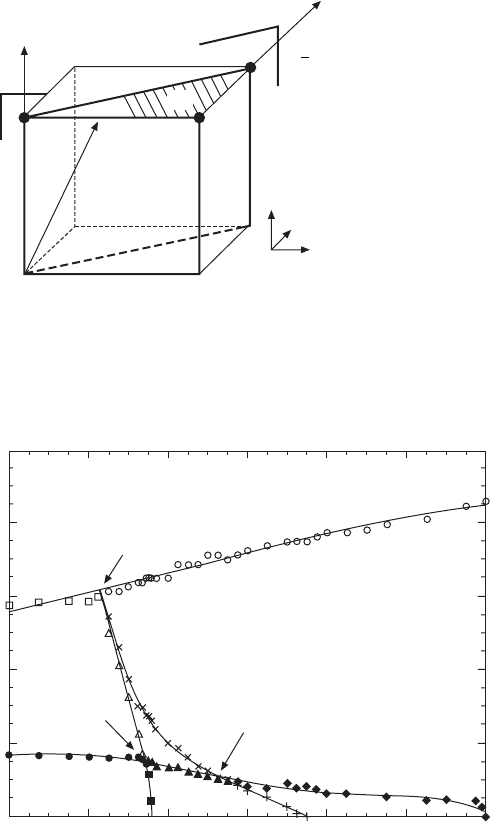
Handbook of dielectric, piezoelectric and ferroelectric materials414
space group should be considered from Rietveld analysis (Ranjan et al.,
2002). Later, the same group reported that the correct space group for this
phase is in fact Cc (Hatch et al., 2002). Moreover recent models involving
mixing with Cc phase were also considered (Cox et al., 2005; Ranjan et al.,
2005). TEM observation by Woodward et al. (2005) suggests a Cc phase and
Pm
(010)
[001]
T
P
Tri
O
[101]
R
[111]
Cm
(11 0)
c
b
a
14.15
Different phases implied in the study of MPB compounds,
described in the pseudo-cubic cell. Monoclinic phase
Pm
is also
denoted M
C
, while
Cm
is also denoted M
A
or M
B
depending on the
direction of polarization above or below the diagonal direction [111].
In between the two monoclinic planes is a triclinic phase. T stands
for tetragonal, O for orthorhombic and R for rhombohedral.
Temperature (K)
1000
800
600
400
200
0
0.44 0.46 0.48 0.50 0.52 0.54 0.56
Ti composition
R
3
c
Cc
I4cm
Cm
3
2
R3m
P4mm
1
Pm3m
14.16
Phase diagram of PZT, from Kornev
et al.
(2006).
WPNL2204
From the structure of relaxors to the structure of MPB 415
underlines the ability of such phase to bridge the R3c and Cm phases. Recently
(Kornev et al., 2006) the Cc phase existence was confirmed as one of the
ground states of PZT but the oxygen octahedra in this Cc phase rotate neither
about the [001] direction nor about the [111] direction, but rather about an
axis that is between these two directions. Interestingly, for the largest Ti
concentrations, a new tetragonal phase with the I4cm space was suggested
and confirmed experimentally. This phase involves the coexistence of
ferroelectricity and rotation of oxygen octahedra, but is associated with the
tetragonal symmetry (unlike R3c and Cc). As a result, an increase in Ti
concentration from 47% to 52% results not only in the continuous rotation of
the spontaneous polarization from [111] to [001], but also in the change of
the oxygen octahedra rotation axis from [111] to [001].
PMN–PT phase diagram
Shortly after the discovery of the monoclinic phase in PZT, the same situation
was reported in PMN–PT with, however, some discussions about the exact
symmetry. Ye et al. (2001) reported a Cm (M
A
) phase whereas we reported
(Kiat et al., 2002) a Pm (M
C
) phase. In fact it appears that both groups were
right (or wrong !) because the three monoclinic phases can appear in addition
to rhombohedral and tetragonal phases, depending on the concentration/
temperature/electric field/pressure/strain ranges; moreover with, in many
cases, the coexistence of phases (Akhilesh Kumar and Dhananjai, 2003;
Akhilesh Kumar et al., 2006; Singh et al., 2006). In fact the path of rotation
experimentally observed with two monoclinic phases when the concentration
is changed, i.e. rhombohedral → M
A
→ M
C
→ tetragonal, was predicted by
Fu and Cohen (2000) and shows how to minimise the internal energy of the
system. Recent results also show that the extent of the MPB appears to be
underestimated (Akhilesh Kumar et al., 2006; Carreaud et al., 2006), as well
as for the rhombohedral phase (Ye et al., 2003). We plot on Fig. 14.17
tentative phase diagram which includes these recent results. The question of
the average symmetry, in particular, in the low PT concentration range is still
a matter of debate: whether it can be more adequately described as an ‘average’
rhombohedral phase or a local monoclinic order is a difficult question, as
explained above. The question of an orthorhombic phase has also been raised
in this system as well as in PZN–PT: we discuss these questions more deeply
in Section 14.4.4 in relation to PSN–PT.
PZN–PT phase diagram
The observation (Lebon et al., 2002) in PZN by our group of splitting at
385K of the [111] cubic peaks as well as anomalous widening of [100] peaks
and the report of a field-induced monoclinic phase (Lebon et al., 2005)
WPNL2204
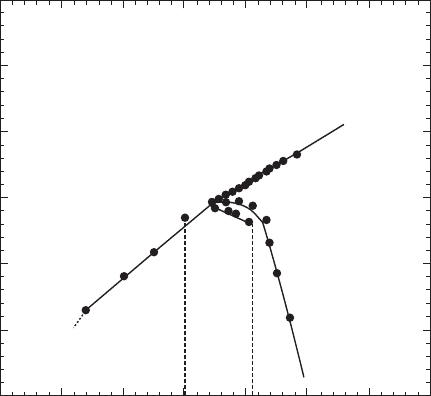
Handbook of dielectric, piezoelectric and ferroelectric materials416
showed that the structure of this system is at least as complex as other
relaxors. Recent results by Jeong and Lee (2006) suggest describing the
rhombohedral phase rather as a mixture of meso-scale PNRs in a disordered
lattice: their results show that in PZN, these PNRs are simply ‘larger’ at
room temperature (150 Å) (La-Orauttapong et al., 2001) than those in PMN
(20Å) so they are visible in powder diffraction measurements as a split of
Bragg peaks. Besides they propose that PZN and PMN have the same ground
state, i.e. mixed state of disordered cubic phase and rhombohedral PNRs.
Another point of view was also proposed and considers another ground state
for PZN as a lower symmetry phase which could be monoclinic rather than
rhombohedral (Bing et al., 2005).
In PZN–PT, since the optical observation by Fujishiro et al. (1998) of
heterophases in PZN–PT9% which showed a lowering of symmetry between
the rhombohedral and tetragonal domains, conflicting reports have been
published regarding the exact symmetry of the MPB. We reported a Pm (M
C
)
phase (Kiat et al., 2002) coexisting with the tetragonal phase whereas an
orthorhombic phase was reported whose unit cell was afterward described in
a monoclinic setting (this confusion was also made in PMN–PT, see pages
419–20). The situation has recently been clarified by Bertram et al. (2003),
who confirm the M
C
as the unique monoclinic MPB phase and clarify the
extent of the MPB as well as the phase coexistence (Fig. 14.18).
Temperature (K)
700
600
500
400
300
200
100
0 0.1 0.2 0.3 0.4 0.5 0.6
Composition PT (
x
%)
14.17
Phase diagram of PMN–PT resulting from computation of
several works (see text).
C
T
M
C
M
B
R
H
WPNL2204
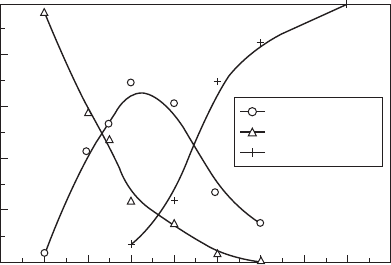
From the structure of relaxors to the structure of MPB 417
PSN–PT system
PSN–PT and PMN–PT phase diagrams show great similarities, with an overall
path of polarisation rotation via M
B
and M
C
monoclinic phases, and a significant
temperature and composition-dependent mixing between these phases.
The complete path of rotation with concentration in PSN–PT has been
precisely studied in our group by Haumont et al. (2003, 2005, 2006a) (Fig.
14.19). In particular, using apparent charge and the results of Rietveld analysis,
they studied the evolution of the polarisation (modulus and angle) inside the
Fu and Cohen cube.
At low temperature, five regions of concentration have been found:
(1) Rh (0 < x ≤ 0.26): The addition of titanium in PSN increases the
rhombohedral distortion as well as amplitudes of shifts of atoms out of
their cubic positions. The polarisation increases from P = 42µC.cm
2
.
(2) Rh→ M
B
(0.26 < x ≤ 0.37): The polarisation rotates in the (011) plane.
The symmetry becomes Cm of the M
B
type; the augmentation of the
amplitude of polarisation is stronger than in the R region.
(3) M
B
→ M
C
(0.37 < x ≤ 0.43): The polarisation goes into the (010) plane,
not via intermediate values (which would have led to a triclinic phase)
but instead through a jump which occurs with strong phase coexistence:
(Cm + Pm). When the titanium concentration increases, the Pm proportion
of phase increases, the polarisation in the (011) plane decreases and
polarisation in the (010) plane increases.
(4) M
C
→ T (0.43 < x ≤ 0.55): The Cm phase has disappeared, P4mm
appears inside the Pm phase and its distortion and proportion increase
with Ti. A rotation of polarisation arises via the phase mixing Pm–
P4mm. The modulus of polarisation of the P4mm increases with Ti. The
monoclinic phase completely disappears at x close to 0.55.
Monoclinic M
c
Rhombohedral
Tetragonal
Volume fraction (%)
100
80
60
40
20
0.05 0.06 0.07 0.08 0.09 0.10 0.11 0.12 0.13 0.14
X
14.18
Extent and volume fractions of the different phases in PZN–PT,
from Bertram
et al.
(2003).
WPNL2204
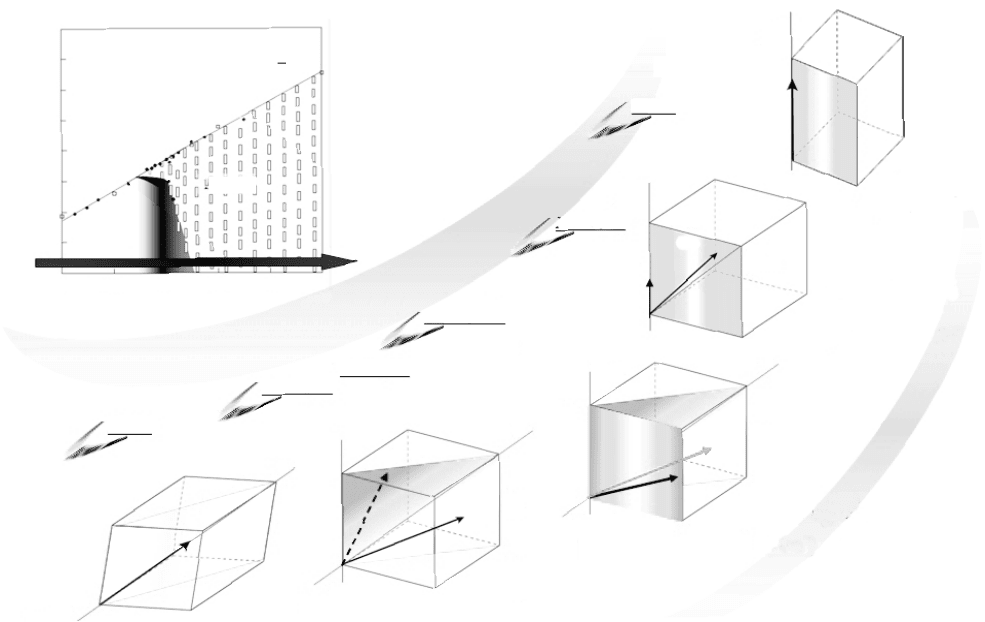
Handbook of dielectric, piezoelectric and ferroelectric materials418
T
(K)
880
800
720
640
560
480
400
320
240
R3m
Pm
Cm
P4mm
Pm3m
0 0.2 0.4 0.6 0.8 1
x
T
<001>
P4mm
[001]
X
= 1
cr
ar
T 92 µC/cm
2
M
C
[1,37 0 1,76]
55 µC/cm
2
T [001] 57 µC/cm
2
T
<001>
x
= 0.43
Mc
O
<101>
Pm
(010)
Cm
(1-10)
T
<001>
M
A
R
M
B
M
C
M
B
[11 11 6] 57 µC/cm
2
M
C
[5 0 3] 60 µC/cm
2
M
B
R
<11
M
A
[113] 56 µC/cm
2
M
B
[551] 52 µC/cm
2
M
A
T
<001>
R
<
R 42 µC/cm
2
R3m
[111]
x
= 0
x
= 0.35
x
= 0.37
x
= 0.415
14.19
Phase diagram with corresponding rotation of polarization in PSN–PT. Notice also the phase coexistence.
WPNL2204
From the structure of relaxors to the structure of MPB 419
(5) T (0.55 < x ≤ 1) : The system is single phased with a polarisation which
increases in a slower way and saturates at P = 92µC/cm
–2
(PT).
Several interesting points have been noticed:
(1) No phase coexistence is found between the rhombohedral and any other
phase. The only report of such coexistence is for R3m + Cm at the
concentration x = 0.31 of PMN–PT by Noheda et al. (2002).
(2) Only 1.5% of titanium separates the two states: (Cm + Pm) and (Pm +
P4mm). An extreme weak change of concentration completely changes
the structure. Although not observed, a single Pm phase may occur at a
very specific concentration between x = 0.415 and x = 0.43. Such single
phases have been reported by Singh et al. (2003) in PMN–PT for x =
0.31 and for x = 0.35 by our group (Kiat et al., 2002).
(3) At concentration x = 0.43 the direction of polarisation of the Pm phase
is very close to the orthorhombic direction [101], but this symmetry is
definitively out of consideration because atoms clearly adopt non-
orthorhombic positions, even though the resulting polarisation stands
close to an orthorhombic direction. This orthorhombic Amm2 symmetry
has also been proposed in PZN–PT, as well as for PMN–PT but only
from a fitting profile of rocking curves, which is in our opinion not
sufficient. On the contrary a monoclinic M
C
phase but with a direction
of polarisation closes to the orthorhombic direction [101] is evidenced
via Rietveld analysis of x = 0.09 in PZN–PT and x = 0.35 in PMN–PT.
The real existence of a ‘true’ orthorhombic phase remains questionable
in these MPB systems.
The temperature evolution of these systems is also complex: for instance
the evolution of PSN–PT x = 0.415 compound’s phase mixing is detailed in
Fig. 14.20. Other concentration evolutions (less detailed) are also shown.
In the x = 0.415 compound, the Cm and Pm phases coexist from the
lowest temperatures up to about 400K when the progressive destabilisation
of the Cm phase is observed. Close to 435 K, the tetragonal P4mm phase was
found, coexisting with the Pm phase, while the Cm phase has vanished.
Above 480K, this tetragonal phase is observed alone up to about 545K, the
temperature at which it transforms toward the high-temperature paraelectric
Pm–3m phase. For highest concentration a coexistence of the Pm and P4mm
phases is observed at low temperature, and a pure tetragonal phase is recovered
above 0.55 concentration of Ti.
Interestingly we have also reported for x = 0.35 in PSN–PT a transition
(observed below room temperature) from a M
A
to a M
B
phase when cooling
which corresponds to a rotation of polarisation inside the (011) plane from
one side to the other side of the rhombohedral [111] direction.
The observation of the phases mentioned shows agreement with predictive
theoretical work by Vanderbilt and Cohen (2001). However, not all experimental
WPNL2204
